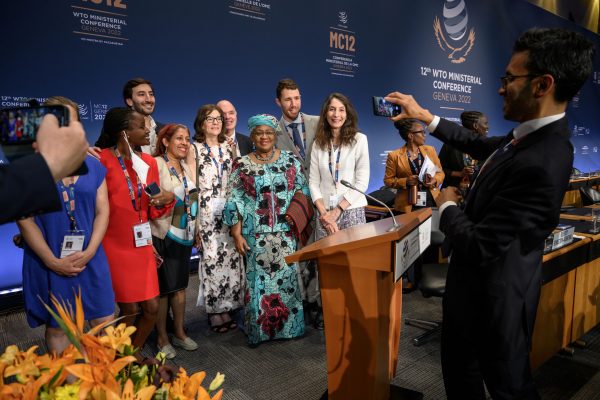The WTO struggles to fulfil two of these three core functions. The WTO’s Doha Round of negotiations broke down without yielding a comprehensive package on market access or updates to WTO trade rules in view of new economic and trade realities such as e-commerce and data flows. The Dispute Settlement Body — the WTO’s court — has lost its quorum to adjudicate trade disputes due to a long-standing US veto against the appointment of new judges.
In response to the crisis engulfing the WTO, policymakers around the world have turned to bilateralism and regionalism in the form of preferential trade agreements (PTAs). Often, PTAs have two parties, while some agreements — such as the Comprehensive and Progressive Agreement on Trans-Pacific Partnership (CPTPP) and the Regional Comprehensive Economic Partnership (RCEP) — have considerably more.
Modern PTAs are typically ‘broad’ as they cover a large number of economic sectors and phenomena ranging from agriculture and manufacturing to services, finance and investment flows. They are also ‘deep’ in the sense that they contain legal commitments that apply well behind borders and directly relate to their signatories’ domestic legal and regulatory systems.
The stalemate in the WTO has fuelled a surge in PTA activity in East Asia and beyond. This narrow focus on PTAs obscures the reality that states have another important tool at their disposal to promote economic cooperation and integration within the WTO regime — plurilateralism.
Plurilateralism brings together an intermediate number of states as plurilateral initiatives comprise more members than most PTAs but not the full membership of the WTO. Plurilateral initiatives are typically narrow, sectorial and deep. They deal with specific economic sectors — such as environmental goods and services — or economic phenomena including e-commerce, services regulation and investment.
Three features stand out as benefits of plurilateral initiatives. First, plurilateralism may facilitate reaching consensus in today’s highly heterogenous global trade regime. It may allow WTO members with little interest in a given domain to stay on the sidelines rather than block initiatives.
Second, plurilateralism may be particularly suitable for modern intrusive trade policy and negotiations. Since the 1990s, trade policy increasingly focusses on positive integration through joint rulemaking. Most of the attention of trade policymakers is on rules. This focus reflects how regulatory heterogeneity — such as diverging product safety or environmental standards — may impose considerable costs on producers.
Unlike tariffs and quotas, rules are intrusive and may interfere with democratic choices and public policies. Limiting the number of parties in negotiations may allow states with similar preferences to cooperate and move towards a point of maximum efficiency without disadvantaging one another.
Third, the larger number of states involved in plurilateral initiatives limits the risk of harmful trade diversion often associated with the rise of bilateralism. Critics stress that PTAs may not generate trade and efficiency gains but merely divert trade flows to PTA partners and perpetuate economic inefficiencies.
Plurilateralism also comes with costs. Plurilateral initiatives are likely to further limit interest in multilateralism. As states increasingly resort to PTAs and eventually to plurilateral initiatives, they exhaust their administrative resources and see little value in cumbersome multilateral negotiations.
Developing countries may also get sidelined through plurilateral initiatives. Major economies may push ahead and agree on common rules and regulatory approaches in emerging sectors without giving developing countries a say in the development of norms. Despite not taking part in plurilateral initiatives, developing countries may have to adopt these norms at some point due to their significance for global trade.
East Asian policymakers should scrutinise the costs and benefits of pursuing closed mega-regional PTAs and consider the option of open plurilateral initiatives.
For East Asia to tap into the potential of plurilateralism it needs to assume leadership. The centre of the world economy has been shifting from the Atlantic to the Pacific and East Asia. Local leaders must be prepared to invest time, political capital and administrative resources to advance discussions on global economic governance.
East Asian policymakers need to reflect on the sectors and policy domains where plurilateral initiatives are most likely to yield benefits and complement PTAs. Two criteria may guide reflections. First, plurilateralism is most beneficial for issues that are of global reach but fail to command serious interest among the full WTO membership. Second, plurilateralism — due to its suitability for international regulatory cooperation — is particularly valuable in tackling issues of a regulatory nature occurring within global value chains.
Well-crafted plurilateralism can ensure greater inclusivity and economic efficiency compared to classic PTAs and mega-regional agreements such as RCEP or the CPTPP, which by design cement rather than bridge economic and political cleavages.
Robert Basedow is Assistant Professor for International Political Economy at the London School of Economics.
This article appears in the most recent edition of East Asia Forum Quarterly, ‘China Now’, Vol 15, No 1.

